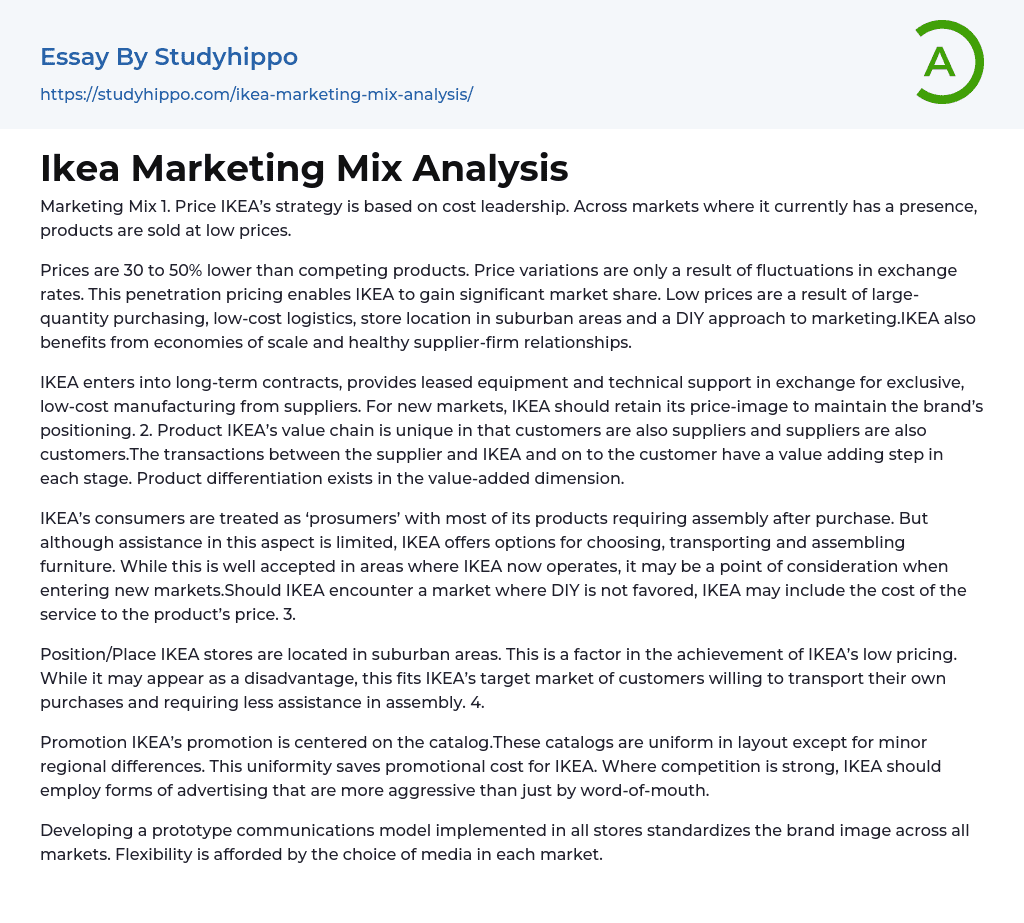Marketing Mix 1. Price IKEA’s strategy is based on cost leadership. Across markets where it currently has a presence, products are sold at low prices.
Prices are 30 to 50% lower than competing products. Price variations are only a result of fluctuations in exchange rates. This penetration pricing enables IKEA to gain significant market share. Low prices are a result of large-quantity purchasing, low-cost logistics, store location in suburban areas and a DIY approach to marketing.IKEA also benefits from economies of scale and healthy supplier-firm relationships.
IKEA enters into long-term contracts, provides leased equipment and technical support in exchange for exclusive, low-cost manufacturing from suppliers. For new markets, IKEA should retain its price-image to maintain the brand’s positioning. 2. Product IKEA’s value chain is unique in that customers are also suppliers and supplier
...s are also customers.The transactions between the supplier and IKEA and on to the customer have a value adding step in each stage. Product differentiation exists in the value-added dimension.
IKEA’s consumers are treated as ‘prosumers’ with most of its products requiring assembly after purchase. But although assistance in this aspect is limited, IKEA offers options for choosing, transporting and assembling furniture. While this is well accepted in areas where IKEA now operates, it may be a point of consideration when entering new markets.Should IKEA encounter a market where DIY is not favored, IKEA may include the cost of the service to the product’s price. 3.
Position/Place IKEA stores are located in suburban areas. This is a factor in the achievement of IKEA’s low pricing. While it may appear as a disadvantage, this fits IKEA’s target market of customers willing to transport their
own purchases and requiring less assistance in assembly. 4.
Promotion IKEA’s promotion is centered on the catalog.These catalogs are uniform in layout except for minor regional differences. This uniformity saves promotional cost for IKEA. Where competition is strong, IKEA should employ forms of advertising that are more aggressive than just by word-of-mouth.
Developing a prototype communications model implemented in all stores standardizes the brand image across all markets. Flexibility is afforded by the choice of media in each market.
- Wal-Mart essays
- Discover essays
- Gas prices essays
- Advertisement essays
- Advertising essays
- Anheuser-busch essays
- Audience Theory essays
- Brand essays
- Brands essays
- Competitor Analysis essays
- Consumer essays
- Detergent essays
- Marketing Management essays
- Marketing Mix essays
- Marketing Plan essays
- Marketing Research essays
- Marketing Strategy essays
- New Product Development essays
- Point Of Sale essays
- Price essays
- Procurement essays
- Product essays
- Product Differentiation essays
- Product Placement essays
- Promotion essays
- Promotion And Marketing Communications essays
- Research Design essays
- Retailing essays
- Trademark essays
- Adidas essays
- Amazon essays
- Apple essays
- Bmw essays
- British Airways essays
- Burger King essays
- Coca-Cola essays
- Company essays
- Costco essays
- Dell essays
- Ebay essays
- Enron essays
- Facebook essays
- Ford Motor Company essays
- Gap essays
- General Motors essays
- Google essays
- Honda essays
- Ibm essays
- Ikea essays
- Intel essays




